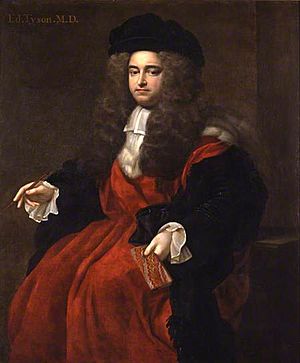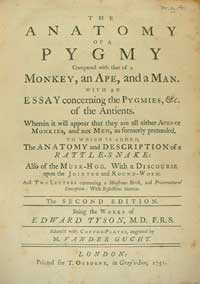Edward Tyson facts for kids
Edward Tyson (born January 20, 1651 – died August 1, 1708) was an English scientist and physician. He is often called the founder of modern comparative anatomy. This is a field where scientists compare the body structures of different kinds of animals.
A Look at His Life
Edward Tyson was born in a town called Clevedon in Somerset, England. He went to Oxford University and earned his first degree (a Bachelor of Arts) in 1670. He later got his Master of Arts degree from Oxford in 1673. In 1678, he earned his Doctor of Medicine degree from Cambridge University.
In 1683, he became a Fellow of the College of Physicians. A year later, in 1684, he became a doctor and leader at Bethlem Hospital in London. This was one of the first hospitals in Britain for people with mental health issues. Edward Tyson is famous for helping to change this hospital. Before him, it was almost like a place where people were just put on display. He helped turn it into a real hospital that aimed to help its patients get better.
He was also chosen to be a Fellow of the Royal Society in 1679, which is a group of important scientists. Edward Tyson was buried at St Dionis Backchurch.
Studying Animal Bodies
Edward Tyson was very interested in how different animals were built. This is what comparative anatomy is all about.
In 1680, he carefully studied a porpoise. He was able to show that a porpoise is actually a mammal, not a fish. He noticed that the porpoise's brain had many folds, just like the brains of animals that live on land, rather than the smoother brains of fish.
In 1698, he studied a chimpanzee that was on display in London. After his studies, he wrote an important book called Orang-Outang, sive Homo Sylvestris: or, the Anatomy of a Pygmie Compared with that of a Monkey, an Ape, and a Man. In this book, he shared his discovery that chimpanzees are more like humans than they are like monkeys. He especially noted how similar their brains were to human brains. This book was so important that it was printed again many years later in 1894.
Tyson also studied a timber rattlesnake in 1683. He wrote one of the first and most accurate descriptions of what's inside a snake's body. He was the first person to describe the special "loreal pits" on the faces of some snakes (like rattlesnakes). However, he didn't realize these pits helped snakes sense heat; he thought they were for hearing.
See also
- Tyson's gland



